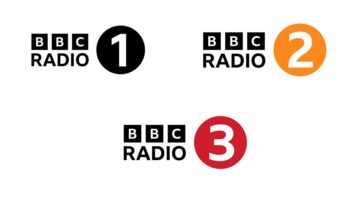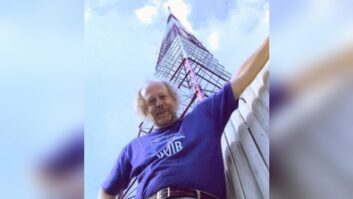With the weather finally moderating in Shropshire in the United Kingdom, long-awaited tests on the Crossed-Field Antenna should soon be underway.
Delayed by rain, snow, ice, illness and injury – not to mention access restrictions thanks to foot-and-mouth disease – the construction of a test CFA in the U.K. neared completion at the end of May, with managers hoping to begin tests this month (June).
In the meantime, developers of another new AM antenna design, the EH antenna in Eatonton, Ga., await word from the FCC, hoping they’ll gain permission to construct and test an antenna in the United States designed for the AM band.
Observers say that real-world tests are critical to determining both antennas’ viability as functional and efficient AM radiators.
Dr. Fahti Kabbary, a co-inventor of the CFA, arrived in early May to finish construction of the CFA antenna, according to Robert Richer, president of Crossed Field Antennas Ltd., Farmington, Conn.
Foot-and-mouth disease has played its part in the CFA delays. The bovine illness produced a quarantine of the test area and its perimeter, halting construction and accompanying tests of the antenna.
“As the weather improves, foot-and-mouth diminishes,” Richer said. “Everyone is scared to death, but we have access to the site, which is a great step forward.”
The British government has authorized facilities of 2 kW at a frequency of 972 kHz, Richer stated. The government also has allowed an occupied bandwidth of 20 kHz for the tests.
The frequency-agile transmitter is being installed by ntl Group Ltd., a communications facilities provider headquartered in Hook, Hampshire, U.K. The company is providing a transmitter specialist and a medium-wave antenna expert to assist with impedance matching at the site.
Ben Dawson of Hatfield & Dawson plans to take extensive field measurements of the CFA, arriving on site this month. George Hagn, now retired from the Washington office of SRI International, is accompanying Dawson. SRI is a global organization that develops applications for businesses, governments and other organizations.
Hagn has developed an open-wire line kit to measure ground conductivity, a measurement that will be critical at Shropshire to help determine the antenna efficiency. The efficiency is a measurement of how well an antenna produces an RF signal given a known input power and impedance.
Richer hopes the field tests will be complete by the end of June. These tests include the following procedures:
Horizontal Plane Radiation Efficiency – This conventional, six-radial proof of performance will measure the field strength on radials spaced 60 degrees apart. Fifteen or 20 evenly spaced points will be used on each radial at distances ranging from 0.1 to 3.0 kilometers from the antenna, and 10 points are measured at distances from 3.0 to 10.0 kilometers from the antenna.
Ground Conductivity Tests – These tests will determine the ability of the ground to propagate an RF signal and will be used as a second independent set of measurements of field strength.
Vertical Radiation Pattern – Measurements will be made using a helicopter provided by the BBC and will be taken at known elevations and distances from the antenna, with a 5-degree vertical resolution. These tests will be critical in determining the shape of the antenna’s pattern as the signal moves at an angle through the sky, ultimately defining how the antenna propagates without causing undue skywave interference.
Near-Field Radiation – These tests will determine if the CFA meets or exceeds the radio frequency radiation standards of the FCC’s Office of Engineering and Technology. CFA proponents claim exceptional performance in this area.
Impedance Bandwidth – These tests are planned to determine the antenna’s ability to produce an audio output of suitable fidelity in a receiver. Critics of the CFA maintain that short radiators, such as the CFA, generally exhibit poor impedance bandwidth characteristics.
Pattern Bandwidth – Measurements will be taken at carrier and sideband frequencies to determine what effect the CFA has on audio bandwidth and to determine if the antenna might create adjacent-channel interference under nighttime (skywave) conditions.
Stability and Sensitivity – These tests will determine how well stations will be able to maintain their licensed radiation patterns with an operating CFA. Far-field measurements will be used to determine the effects on the field strength and pattern variations under different, but controlled, variations in the system input voltage and current.
Frequency Scalability and Ground Effects – Prior to any FCC approval, it will be necessary to be able to predict the performance of a CFA at frequencies other than the ones used for the tests, specifically across the AM band. If the CFA’s performance is less dependent on wavelength than conventional AM towers, it may be possible to define the characteristics of the CFA in a frequency-independent way.
Richer stated that the measurements will be made solely by Dawson and Hagn to eliminate any possible bias introduced into the results by members of the CFA team, including Richer and Kabbary, who will be on site during some of the tests.
Some preliminary test data may be available as early as the end of June.
EH word
Meanwhile, developers of the EH antenna await word from the FCC about a test permit.
In March, the Mass Media Bureau dismissed an application filed in August 2000 by EH Antenna Systems, Eatonton, Ga., with the FCC to test an EH antenna.
The request for authority to test an antenna on 1590 kHz at 100 watts was denied for a variety of technical reasons, one of which concerned potential interference to co- and adjacent channels.
In addition, in a letter to Hart and copied to his consulting engineer Stu Graham of Graham Brockman Inc., the bureau stated, “given the high level of existing interference at the site,” the proposed test facility would be subject to interference, resulting in inaccurate measurements of the EH antenna’s performance.
Graham has been working since that dismissal with OET to obtain permission to test the antenna.
Ted Hart, CEO of EH Antenna Systems, stated that OET has forwarded a revised application to the MMB for frequency coordination.












